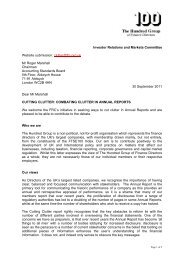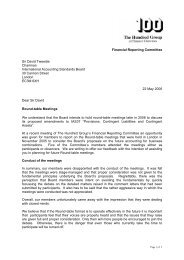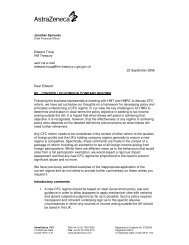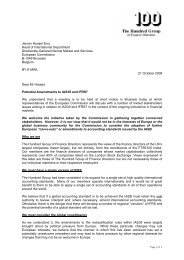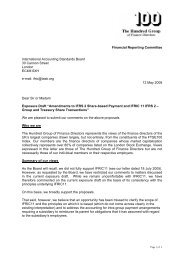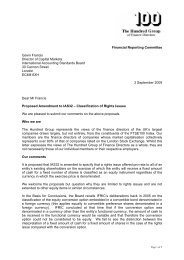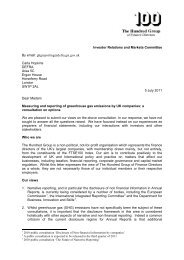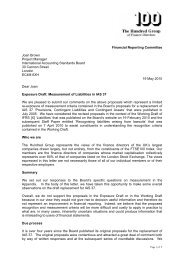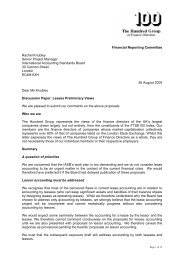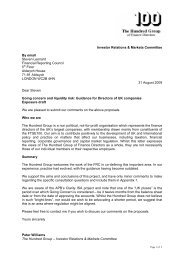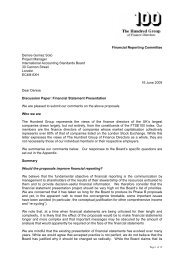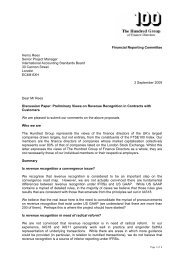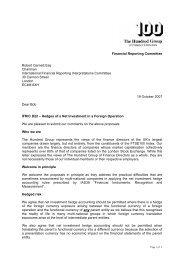Financial Reporting Committee Jon Nelson Project Manager ...
Financial Reporting Committee Jon Nelson Project Manager ...
Financial Reporting Committee Jon Nelson Project Manager ...
Create successful ePaper yourself
Turn your PDF publications into a flip-book with our unique Google optimized e-Paper software.
<strong>Jon</strong> <strong>Nelson</strong><br />
<strong>Project</strong> <strong>Manager</strong><br />
International Accounting Standards Board<br />
30 Cannon Street<br />
London<br />
EC3M 6XH<br />
Dear Mr <strong>Nelson</strong><br />
Discussion Paper - Fair Value Measurements<br />
<strong>Financial</strong> <strong>Reporting</strong> <strong>Committee</strong><br />
4 May 2007<br />
I am pleased to submit The Hundred Group’s comments on the above proposals. Our overall<br />
comments are set out below. Reponses to your specific questions are dealt with in the<br />
Appendix.<br />
The Hundred Group of Finance Directors represents the views of the finance directors of the<br />
UK’s largest companies drawn largely, but not entirely, from the constituents of the FTSE100<br />
Index. Our members are the finance directors of companies whose market capitalisation<br />
collectively represents over 80% of companies listed on the London Stock Exchange. Views<br />
expressed in this letter are those of The Hundred Group of Finance Directors but are not<br />
necessarily those of our individual members or their respective employers.<br />
BACKGROUND TO OUR COMMENTS<br />
Welcome in principle<br />
We welcome in principle the proposal to provide “one-stop guidance” on fair value<br />
measurement. However, we do not believe that there is necessarily one answer to the<br />
measurement of fair value, i.e. we do not believe that it will always be appropriate to measure<br />
fair value on an exit price basis.<br />
Scope of fair value measurement<br />
We acknowledge that the Discussion Paper deals only with the measurement of fair value and<br />
does not propose any extension of the use of fair value as a basis of measurement. We have<br />
therefore prepared this response on the assumption that there will be no change in the extent<br />
to which fair value is used as the measurement basis within the existing mixed measurement<br />
accounting model.<br />
We expect that the Board will address the scope of fair value measurement in due course in<br />
the context of its conceptual framework project. We have strong reservations about the<br />
Discussion Paper even given the current scope of fair value measurement. If the Board was
to propose a significant extension in the use of fair value measurement, we believe that it<br />
would be necessary to revisit any guidance that emerges from consideration of the current<br />
proposals.<br />
Heritage of SFAS 157<br />
We understand the reason why the Board has used the US standard, SFAS157 “Fair Value<br />
Measurements”, as the starting point for its discussion of fair value measurement. However,<br />
we do not believe that SFAS157 is sufficiently broadly-based to provide a solution that is<br />
workable in the context of IFRS.<br />
SFAS157 is designed for use in a US reporting environment where there is relatively little use<br />
of fair value measurement. SFAS157 is clearly focussed on fair value measurement in the<br />
context of financial instruments (many of the questions that the Board has asked respondents<br />
reflect this focus).<br />
Our principles<br />
While the Discussion Paper restricts itself to the measurement of fair value, consideration of<br />
the Discussion Paper inevitably brings one to consider the potential for the wider use of fair<br />
value as a basis of measurement.<br />
We do not oppose the use of fair value measurement in principle provided it is used in<br />
situations where it is relevant to the needs of users of financial statements and can be<br />
determined on a reliable basis.<br />
We view financial reporting as a practical exercise in communication, not as a theoretical or<br />
academic construct. Communication is built upon characteristics of understandability,<br />
transparency, relevance and reliability. We believe that these considerations should be<br />
central to all projects the Board undertakes. We question whether the wider use of fair value<br />
could be justified in the context of these characteristics. Indeed, we question whether even<br />
some of the current uses of fair value meet these characteristics (for example, in our<br />
experience, many users do not see any relevance in ascribing fair values to intangible assets<br />
acquired in a business combination).<br />
We are concerned that in paragraph C2 of SFAS157, the FASB states that “In many<br />
accounting pronouncements, the Board has concluded that fair value information is relevant,<br />
and users of financial statements generally have agreed.” We do not see much evidence in<br />
practice that users regard fair value information to be relevant except perhaps in the context of<br />
financial instruments for which liquid markets exist. We therefore suggest that before<br />
progressing further with its fair value agenda, the Board should engage user groups to<br />
determine their real needs.<br />
OUR PRINCIPAL CONCERNS<br />
Exit price<br />
We do not believe that there is necessarily one answer to the measurement of fair value. We<br />
believe that fair value can mean different things in different contexts and will not always be an<br />
exit price as is suggested in the Discussion Paper. While the exit price basis of measuring fair<br />
value propounded by SFAS157 may arguably be relevant in the context of financial<br />
instruments, we struggle to see how it is appropriate in certain other contexts, e.g. in the<br />
allocation of purchase consideration to acquired assets and liabilities in a business<br />
combination. We find it interesting share-based payments are outside the scope of SFAS157<br />
because this is one of the principal areas in which fair value is used as a measurement basis<br />
under US accounting standards and one where the entry price basis of measuring fair value is
clearly more appropriate than the exit price basis. We do not believe that it will usually be<br />
appropriate for the transfer price to be used as the basis for measuring the fair value of a<br />
liability (even if an observable transfer price exists). Indeed, we suspect that there may be<br />
some confusion between the exit price for a holder of a liability as an asset (which may be<br />
readily available) and the transfer price for the issuer of the liability.<br />
Where liquid markets exist, there may in practice be very little difference between exit and<br />
entry prices but, where liquid markets do not exist (which we contend is likely to be the case in<br />
most situations where fair value is used in practice) there could be significant differences<br />
between these prices.<br />
We believe that where fair value is used, it should reflect the context in which the asset or<br />
liability is being measured. We therefore suggest that the fair value measurement standard<br />
should provide guidance on the various methods of determining fair value that are prescribed<br />
in individual standards.<br />
We support the Board’s plan to carry out a standard by standard review of existing IFRSs to<br />
determine the relevant measurement attribute in each situation.<br />
Market participant view<br />
We struggle with the concept of a market participant as defined in SFAS157. Market<br />
participants are defined as buyers and sellers in the principal (or most advantageous) market<br />
that are independent of the reporting entity. We believe that fair value should be assessed<br />
from the perspective of the reporting entity that actually holds the asset or owes the liability.<br />
We do not welcome the additional complexity that is added by the reliance on the perspective<br />
of hypothetical market participants.<br />
We believe that fair value will typically be measured using Level 3 inputs, i.e. in the absence<br />
of prices taken either directly or adjusted from active markets. In this context, it will be<br />
necessary for entities to take into account their own plans and expectations. Yet the Board<br />
would require entities to further adjust their own estimates to take into account the market<br />
participant view. In the words of SFAS157, “unobservable inputs shall reflect the reporting<br />
entity’s own assumptions about the assumptions that market participant would use in pricing<br />
the asset or liability (including assumptions about risk)”. While we believe that it is appropriate<br />
to require reporting entities to make assumptions about their own future, we do not think it is<br />
reasonable to expect them to make assumptions about the views of the market participant.<br />
For one thing, the theory is based on the notion that all market participants are homogeneous<br />
whereas in reality this is of course not the case. So, which market participant view should the<br />
reporting entity choose?<br />
Faced with this difficulty, we believe that in practice entities may respond either by applying a<br />
standard adjustment factor to their own calculations to acknowledge the market participant<br />
view or will assume that there is no difference between their own assumptions and those of<br />
the market participant.<br />
We find it strange that the Board should contemplate an entity reporting to its shareholders<br />
asset values that are based on the circumstances and intentions of a hypothetical market<br />
participant rather than on the entity’s own circumstances and the intentions of its own<br />
management. We believe that the results would be potentially spurious and misleading to<br />
users of financial statements.<br />
We suggest that the Board seeks to compromise between theory and practicality. After all,<br />
fair value measurement using unobservable inputs is a far from exact science. We would<br />
welcome an entity specific value that is consistent with the “through the eyes of management”
approach which the Board has started to favour recently and which we believe is a far more<br />
useful measure for users.<br />
Unobservable inputs (Level 3 inputs)<br />
While we agree with the fair value hierarchy in SFAS157, we are concerned that the FASB<br />
may have an unrealistic view of the extent to which Level 3 inputs will be relied upon in<br />
practice. We sense that the FASB contemplates that fair values will be based more often than<br />
not on Level 1 or Level 2 inputs.<br />
We believe that in practice the lack of observable prices in liquid markets in many situations<br />
will cause the majority of fair values to be based on Level 3 inputs. We are concerned that fair<br />
values based on unobservable inputs will lack reliability. We do not believe that a<br />
measurement basis that lacks reliability should be used in financial statements.<br />
Cost-benefit analysis<br />
Whilst we acknowledge the Discussion Paper is setting out guidance on how fair value should<br />
be derived, we still believe that some form of cost-benefit analysis should be performed, not<br />
least as this would highlight the impracticability and unreliability of the use of unobservable<br />
inputs. We would gladly assist in any road testing of the methods contained in the proposals.<br />
Round-table meetings<br />
We welcome the Board’s intention to hold round-table meetings to consider the issues raised<br />
in the Discussion Paper. We would be pleased to participate in the meetings.<br />
Please feel free to contact me if you wish to discuss our comments on the Board’s proposals.<br />
Yours sincerely<br />
Ken Lever<br />
Chairman<br />
The Hundred Group - <strong>Financial</strong> <strong>Reporting</strong> <strong>Committee</strong>
APPENDIX<br />
Question 1 – SFAS 157 and fair value measurement guidance in current IFRSs<br />
In your view, would a single source of guidance for all fair value measurements in<br />
IFRSs both reduce complexity and improve consistency in measuring fair value? Why<br />
or why not?<br />
Current guidance on fair value measurement is spread across a number of standards and is<br />
inconsistent. Consequently, in principle, one source of guidance for all fair value<br />
measurements would be welcome. We do not, however, expect that the existence of one<br />
source of guidance on fair value measurement will necessarily reduce complexity. We believe<br />
that fair value measurement is inherently complex. We are concerned that the Board has<br />
taken a rather simplistic view of fair value, i.e. that it is an exit value that will usually be<br />
ascertainable in an environment of quoted prices in active markets. In our view, the term fair<br />
value can and should mean different things in different circumstances and, in practice, fair<br />
value measurement will most often be undertaken in an environment of unobservable prices.<br />
Unless there is extensive guidance (which may add to the complexity), there will be no<br />
consistency achieved for unobservable prices.<br />
Question 2:<br />
Is there fair value measurement guidance in IFRSs that you believe is preferable to the<br />
provisions of SFAS 157? If so, please explain.<br />
We are concerned that SFAS157 was developed in the context of existing US reporting<br />
requirements where there is relatively little use of fair value measurement. We believe that<br />
this is reflected in the fact that SFAS157 is very much focused on financial instruments. We<br />
are therefore not convinced that SFAS157 is appropriate for use in the context of current<br />
IFRSs where there is more extensive use of fair value measurement. We certainly do not<br />
think that SFAS157 would provide sufficient guidance if the use of fair value measurement<br />
was to be extended under IFRSs.<br />
We suggest that the guidance on fair value in IAS40 “Investment Property” contains valuable<br />
material which should be retained. We believe that IAS41 “Agriculture” provides clearer<br />
guidance than SFAS157 on circumstances in which an entity should choose between different<br />
markets. IAS41 establishes the principle that where an entity has access to two different<br />
markets it should refer to the one that it is expects to use. We believe that this principle<br />
applied more widely would ensure that fair values reflect amounts that are likely to be<br />
achieved in practice rather than the fair value that could be achieved in the principal (or most<br />
advantageous) market. For example, it may not be possible for an entity to sell all of its<br />
products in the principal (or most advantageous) market because sufficient capacity may not<br />
exist in that market.<br />
We support the Board’s plan to carry out a standard by standard review of existing IFRSs to<br />
determine the relevant measurement attribute in each situation. We are particularly<br />
concerned that the exit price methodology of SFAS157 is not appropriate in the context of<br />
business combinations and urge that the Board’s review encompasses the proposed revisions<br />
to IFRS3 “Business Combinations”.
Question 3 – Exit price measurement objective<br />
Do you agree that fair value should be defined as an exit price from the perspective of a<br />
market participant that holds the asset or owes the liability? Why or why not?<br />
We believe that this question raises two issues. First, whether fair value should be defined as<br />
an exit price. Second, whether fair value should be assessed from the perspective of a<br />
market participant.<br />
We do not believe that it is always appropriate to define fair value in terms of an exit price. It<br />
may be more relevant to define it as an entry price or in other terms. Under existing IFRSs<br />
there are broadly three uses of fair value:<br />
a) as a proxy for historical cost where historical cost is not available, e.g. for measuring<br />
assets and liabilities acquired in a business combination;<br />
b) in impairment testing, e.g. assessing the recoverable amount of property, plant and<br />
equipment; and<br />
c) as a measure of current value where historical cost is not considered to be relevant, e.g.<br />
in the valuation of available-for-sale investments.<br />
Where fair value is used as a proxy for historical cost, it seems logical that the fair value<br />
should be measured as an entry price. Where fair value is used as a measure of recoverable<br />
amount it seems logical that fair value should be measured as an exit price. Where fair value<br />
is used as a measure of current value fair value may reasonably be measured as an exit price<br />
and entry price or a mid-market price and in practice each is used in different circumstances.<br />
Where liquid markets exist, there may in practice be very little difference between exit and<br />
entry prices but, where liquid markets do not exist (which we contend is likely to be the case in<br />
most situations where fair value is used in practice) there could be significant differences<br />
between these prices.<br />
We struggle with the concept of a market participant as defined in SFAS157. Market<br />
participants are defined as buyers and sellers in the principal (or most advantageous) market<br />
that are independent of the reporting entity. We believe that fair value should be assessed<br />
from the perspective of the reporting entity that actually holds the asset or owes the liability.<br />
We do not welcome the additional complexity that is added by the reliance on the perspective<br />
of hypothetical market participants.<br />
To illustrate, paragraph 5 of SFAS 157 refers to an “orderly transaction between market<br />
participants”. Where a market does not exist, there is no orderly transaction and the concept<br />
is hypothetical (this is acknowledged by the FASB in paragraph C26 of SFAS157). We do not<br />
support the inclusion in financial statements of amounts based on hypothetical transactions in<br />
hypothetical markets. We struggle to see how such amounts could meet the qualitative<br />
characteristics of reliability, relevance and understandability.<br />
Question 4:<br />
Do you believe an entry price also reflects current market-based expectations of flows<br />
of economic benefit into or out of the entity? Why or why not? Additionally, do you<br />
agree with the view that, excluding transaction costs, entry and exit prices will differ<br />
only when they occur in different markets? Please provide a basis for your views.<br />
We do not believe that it is always appropriate to define fair value in terms of an exit price. It<br />
may be more relevant to define it as an entry price or in other terms depending on the<br />
circumstances.
We agree that in perfectly competitive markets asset prices reflect the markets expectations of<br />
the future cash flows attaching to them and entry and exit prices will differ only because of<br />
transaction costs. However, perfectly competitive markets exist only in economic theory and<br />
we do not believe that the concept provides a sound foundation for credible accounting<br />
standards.<br />
Question 5:<br />
Would it be advisable to eliminate the term ‘fair value’ and replace it with terms, such<br />
as ‘current exit price’ or ‘current entry price’ that more closely reflect the measurement<br />
objective for each situation? Please provide a basis for your views.<br />
We believe that it would be advisable to eliminate the term “fair value”. We believe that fair<br />
value may be defined differently in different circumstances. We therefore suggest that rather<br />
than the term “fair value”, standards use more specific terms such as “current exit price”,<br />
“current entry price” or “mid-market price” which actually describe the measurement objective<br />
for each situation.<br />
Question 6:<br />
Does the exit price measurement objective in SFAS 157 differ from fair value<br />
measurements in IFRSs as applied in practice? If so, which fair value measurements in<br />
IFRSs differ from the measurement objective in SFAS 157? In those circumstances, is<br />
the measurement objective as applied in practice an entry price? If not, what is the<br />
measurement objective applied in practice? Please provide a basis for your views.<br />
We have identified the following instances within existing IFRSs where, in practice, fair value<br />
is measured on an entry price basis:<br />
• IFRS3 “Business Combinations” in the measurement of an acquiree’s identifiable<br />
assets and liabilities at the date of acquisition.<br />
• IFRS2 “Share-based Payment” in the measurement of goods and services received in<br />
return for share-based payments.<br />
• IAS39 “<strong>Financial</strong> Instruments: Recognition and Measurement” in the measurement of<br />
financial instruments on initial recognition.<br />
• IAS38 “Intangible Assets” in the measurement of the cost of an intangible asset<br />
acquired in exchange for a non-monetary asset or assets.<br />
• IAS18 “Revenue” in the measurement of the fair value of goods and services received.<br />
• IAS17 “Leases” in the measurement of leased assets at the commencement of the<br />
lease term.<br />
• IAS16 “Property, plant and equipment” in the measurement of the cost of property,<br />
plant and equipment acquired in exchange for a non-monetary asset or assets.<br />
As each of these examples deals with initial measurement on entry into a transaction it seems<br />
to us that the use of an exit price to measure fair value is counter-intuitive and fair value<br />
should be measured on an entry price basis. We believe that the basis of measuring fair<br />
value should be meaningful in the circumstances and we do not believe that it will always be<br />
appropriate to measure fair value on an exit price basis.<br />
Based on the above examples (there may be more), we are firmly of the view that the<br />
adoption of SFAS157 would change accounting practice under existing IFRSs.
Question 7 – Market participant view<br />
Do you agree with how the market participant view is articulated in SFAS 157? Why or<br />
why not?<br />
While we agree that the market participant view is appropriate in theory where perfect markets<br />
exist, we struggle to see how it could be meaningfully applied in practice. Perfect markets do<br />
not exist and we fail to see how reliance on this concept (if indeed possible) can meet the<br />
qualitative characteristics of relevance, reliability and understandability.<br />
We believe that fair value will typically be measured using Level 3 inputs, i.e. in the absence<br />
of prices taken either directly or adjusted from active markets. In this context, it will be<br />
necessary for entities to take into account their own plans and expectations. Yet the Board<br />
would require entities to further adjust their own estimates to take into account the market<br />
participant view. In the words of SFAS157, “unobservable inputs shall reflect the reporting<br />
entity’s own assumptions about the assumptions that market participant would use in pricing<br />
the asset or liability (including assumptions about risk)”. While we believe that it is<br />
appropriate to require reporting entities to make assumptions about their own future, we do<br />
not think it is reasonable to expect them to make assumptions about the views of the market<br />
participant. For one thing, the theory is based in the notion that all market participants are<br />
homogeneous whereas in reality this is of course not the case. So, which market participant<br />
view should the reporting entity choose? Faced with this difficulty, we believe that in practice<br />
entities may respond either by applying a standard adjustment factor to their own calculations<br />
to acknowledge the market participant view or will assume that there is no difference between<br />
their own assumptions and those of the market participant.<br />
We suggest that in its final proposals, the Board seeks to compromise between theory and<br />
practicality. After all, fair value measurement using unobservable inputs is a far from exact<br />
science.<br />
Question 8:<br />
Do you agree that the market participant view in SFAS 157 is consistent with the<br />
concepts of ‘knowledgeable, willing parties’ and ‘arms length transaction’ as defined in<br />
IFRSs? If not, how do you believe they differ?<br />
We believe that the market participant view in SFAS 157 is broadly consistent with the<br />
concepts of “knowledgeable, willing parties” and “arms length transaction” as defined in<br />
IFRSs. However, we believe that the definition of market participants as buyers and sellers in<br />
the principal (or most advantageous) market for an asset or liability sits uneasily with the<br />
measurement of fair value based on unobservable inputs. SFAS157 requires that<br />
unobservable inputs shall be used to measure fair value to the extent that observable inputs<br />
are not available in situations where there is little, if any, market activity for the asset or<br />
liability. We suggest that the Board asks itself how a market participant view can be relevant<br />
where there is little or no market activity. We believe that the concepts of “knowledgeable,<br />
willing parties” and “arms length transaction” as defined in IFRSs are actually more<br />
appropriate than the market participant view where there is reliance on unobservable inputs.<br />
Question 9 – Transfer versus settlement of a liability<br />
Do you agree that the fair value of a liability should be based on the price that would be<br />
paid to transfer the liability to a market participant? Why or why not?<br />
We recognise that there is a case in theory for using transfer prices to measure liabilities on<br />
the basis that the transfer of a liability is the logical equivalent to the sale of an asset. We also<br />
recognise that the use of transfer prices may be appropriate where active markets exist for the<br />
transfer of liabilities.
Our difficulty with this aspect of the proposals is that, once again, there is a disconnect<br />
between theory and practicality. In practice, active markets exist for the transfer of very few<br />
liabilities (typically only certain financial liabilities). While some argue that markets exist for<br />
the transfer of securitised debt, we think that it is important to appreciate that prices in these<br />
markets represent the amount that an investor would have to pay to acquire the debt from the<br />
existing holder rather than the amount that the issuer of the debt would have to pay to transfer<br />
the obligation to service the debt to a third party. Even where a market exists for the transfer<br />
of a liability, it may not be possible for all entities to obtain a meaningful transfer price for their<br />
liabilities because of limitations on the capacity of the market, e.g. for the buy-out of pension<br />
obligations.<br />
Under existing IFRSs, the measurement of an asset reflects the best estimate of the future<br />
cash flows in relation to the asset in the context of management’s intentions towards it. So,<br />
for example, if an entity holds an item of equipment to use in its business the equipment is<br />
measured at the lower of its cost and its recoverable amount, whereas if it intends to sell the<br />
asset it is measured at the lower of cost and fair value less cost to sell. We believe that the<br />
measurement of a liability should similarly reflect management’s intentions. If management<br />
intends to transfer a liability, it would be appropriate to measure the liability on a transfer price<br />
basis. If, however, management intends to settle the liability (whether by performance or early<br />
repayment) it would be appropriate to measure the liability based on the cash flows expected<br />
to be incurred in settlement (including, where relevant, early settlement penalties).<br />
Question 10:<br />
Does the transfer measurement objective for liabilities in SFAS 157 differ from fair<br />
value measurements required by IFRSs as applied in practice? If so, in practice which<br />
fair value measurements under IFRSs differ from the transfer measurement objective in<br />
SFAS 157 and how do they differ?<br />
We are aware that there was some discussion of current practice in measuring provisions<br />
under IAS37 “Provisions, Contingent Liabilities and Contingent Assets” at the London<br />
sessions of the FASB/IASB Roundtable on Liabilities in December 2006. While certain Board<br />
members expressed the view that IAS37 already requires liabilities to be measured on a<br />
transfer price basis, none of the participants (were they preparers, auditors or users) either<br />
shared this view or had applied the standard using transfer prices. We believe that any move<br />
to require preparers to use the transfer price basis in practice would represent a change in the<br />
basis of measurement of provisions. Such a change should be the subject of a wider debate<br />
and should not be imposed by the application of a standard that is intended to provide<br />
guidance on applying a measurement basis rather than changing the applicable measurement<br />
bases themselves.<br />
Under IAS37, the amount recognised as a provision shall be the best estimate of the<br />
expenditure required to settle the present obligation at the balance sheet date. Paragraph 37<br />
of IAS37 states that this is “the amount that an entity would rationally pay to settle the<br />
obligation at the balance sheet date or to transfer it to a third party at that time”. We believe<br />
the key phrase is “would rationally pay”. In the words of the standard itself “it will often be<br />
impossible or prohibitively expensive to settle or transfer an obligation at the balance sheet<br />
date”. In reality, entities are unlikely to rationally pay to settle or transfer a liability at a<br />
significant premium.<br />
We believe that the application of IAS37 in practice reinforces our view that the measurement<br />
of a liability should reflect the best estimate of the future cash flows in relation to the liability in<br />
the context of management’s intentions towards it.
Question 11 – Transaction price and fair value at initial recognition<br />
In your view is it appropriate to use a measurement that includes inputs that are not<br />
observable in a market as fair value at initial recognition, even if this measurement<br />
differs from the transaction price? Alternatively, in your view, in the absence of a fair<br />
value measurement based solely on observable market inputs, should the transaction<br />
price be presumed to be fair value at initial recognition, thereby potentially resulting in<br />
the deferral of day-one gains and losses? Please give reasons for your views.<br />
We do not believe that in the vast majority of cases, it would be appropriate to use a<br />
measurement that includes inputs which are not observable in a market as fair value at initial<br />
recognition.<br />
We therefore believe that where there is an observable price at which a transaction took<br />
place, there should be a rebuttable presumption that the transaction should be initially<br />
recognised at the transaction price, i.e. the transaction price should be presumed to be the fair<br />
value at initial recognition (there may be some exceptions to this rule for example, in the case<br />
of related party transactions).<br />
Question 12:<br />
Do you believe that the provisions of SFAS 157, considered in conjunction with the unit<br />
of account guidance in IAS 39, would result in a portfolio based valuation of identifiable<br />
risks of instruments considered in aggregate, or an in-exchange exit price for the<br />
individual instruments? Please give reasons for your views.<br />
We believe that the unit of account guidance contained in IAS39 “<strong>Financial</strong> Instruments:<br />
Recognition and Measurement” is unclear and would not be improved by SFAS157. We<br />
recommend that the Board reviews the unit of account guidance as part of the “Measurement“<br />
phase of the conceptual framework project. Consistent with our views on the basis of<br />
measurement, we believe that the unit of account used to measure assets and liabilities<br />
should reflect management’s intentions.<br />
Question 13 – Principal (or most advantageous) market<br />
Do you agree that a fair value measurement should be based on the principal market<br />
for the asset or liability or, in the absence of a principal market, the most advantageous<br />
market for the asset or liability? Why or why not?<br />
We are concerned that the application of this principle as currently worded could cause fair<br />
values to be overstated in certain situations. Take, for example, a car manufacturer that<br />
produces five million vehicles per annum and whose most advantageous market is the United<br />
Kingdom where there is total annual demand for two million vehicles per annum. As worded,<br />
SFAS157 would require the manufacturer to measure the fair value of its entire production<br />
based on selling prices in the United Kingdom. Clearly this is unrealistic because even if the<br />
manufacturer supplied every vehicle purchased in the United Kingdom it would still have to<br />
sell three million vehicles per annum in other less advantageous markets.<br />
Certain manufacturers are not limited by the capacity of the principal or most advantageous<br />
market, but produce related products. It may be necessary for that manufacturer to sell a<br />
product in a less advantageous market in order to provide a full product offering in that<br />
market.<br />
So, in our view, while we agree that fair value measurement should certainly consider the<br />
principal or most advantageous market, consideration should also be given to the capacity of<br />
that market, the need to sell into less advantageous markets and any other relevant<br />
circumstances.
The move towards a “through the eyes of management” approach in other standard setting<br />
areas is to be welcomed and we see no reason why this particular aspect of fair value<br />
measurement should not be similar.<br />
Question 14 – Attributes specific to the asset or liability<br />
Do you agree that a fair value measurement should consider attributes specific to the<br />
asset or liability that market participants would consider in pricing the asset or<br />
liability? If not, why?<br />
We agree.<br />
Question 15:<br />
Do you agree that transaction costs that would be incurred in a transaction to sell an<br />
asset or transfer a liability are an attribute of the transaction and not of the asset or<br />
liability? If not, why?<br />
Obviously, transaction costs arise from the transaction to buy, sell or transfer an asset or a<br />
liability. However, this does not necessarily preclude them from being taken into account in<br />
the measurement of assets and liabilities, e.g. where an asset is measured at cost, it is<br />
appropriate to include transaction costs incurred in acquiring the asset (because it forms part<br />
of the cost of the asset).<br />
We believe that transaction costs should be addressed in individual standards in a manner<br />
consistent with the measurement basis adopted in each standard. We find this approach in<br />
existing IFRSs. For example, IAS39 “<strong>Financial</strong> Instruments: Recognition and Measurement”<br />
prohibits the deduction of future selling costs from the carrying amount of financial assets<br />
designated as held to maturity whereas IFRS5 “Non-current Assets Held for Sale and<br />
Discontinued Operations” requires assets that are classified as held for sale to be measured<br />
at fair value less costs to sell.<br />
We believe that there is some confusion as to what constitutes transaction costs (in particular,<br />
whether a bid offer spread should be included within transaction costs). We would therefore<br />
welcome clarification from the Board as to the definition of transaction costs.<br />
Question 16 – Valuation of liabilities<br />
Do you agree that the risk of non-performance, including credit risk, should be<br />
considered in measuring the fair value of a liability? If not, why?<br />
We do not believe that the inclusion of non-performance risk in the estimation of fair value is<br />
consistent with the Board’s view that the fair value of a liability should be measured on a<br />
transfer price basis. Surely, in the context of the price that an entity must pay to transfer the<br />
obligation to service a liability to another party, the risk that the entity itself will not perform<br />
becomes irrelevant (because the liability is no longer that of the entity)? We also believe that if<br />
non-performance risk were to be taken into account in measuring the fair value of a liability<br />
there may be perverse accounting results. For example, take an entity that has issued a<br />
bond. If the entity’s credit rating were to decline, the fair value of the bond would decrease and<br />
the entity would recognise a gain on fair valuing the bond. We believe that this would be<br />
potentially misleading to users of financial statements.
Question 17 – ‘In-use valuation premise’ versus ‘value in use’<br />
Is it clear that the ‘in-use valuation premise’ used to measure the fair value of an asset<br />
in SFAS 157 is different from ‘value in use’ in IAS 36? Why or why not?<br />
We do not agree with the use of the “in-use valuation premise” in SFAS157, but we believe<br />
that the distinction between the concepts of “in-use valuation premise” and “value in use”<br />
should be clear to those who have had time to read the standard several times. However, we<br />
believe that the distinction is far from clear on first reading the standard and this is due to the<br />
similar terminology used to convey very different messages. We suggest that the “in-use<br />
valuation premise “ could be more accurately termed “value in use by the potential acquirer”<br />
and “value in use” could be more accurately termed “value in use by the holder”.<br />
We believe that the “in-use valuation premise” follows logically enough from the market<br />
participant view. However, while we agree that the market participant view is appropriate in<br />
theory, we struggle to see how it could be meaningfully applied in practice. We believe that<br />
the practical difficulties stem from the “in-use valuation premise”. We do not think it is<br />
reasonable to expect entities to make assumptions about the views of the market participant.<br />
Faced with this difficulty, we believe that in practice entities may respond either by applying a<br />
standard adjustment factor to their own calculations to acknowledge the market participant<br />
view or will assume that there is no difference between their own assumptions and those of<br />
the market participant. We find it strange that the Board should contemplate an entity<br />
reporting to its shareholders asset values that are based on the circumstances and intentions<br />
of a hypothetical market participant rather than on the entity’s own circumstances and the<br />
intentions of its own management. We believe that the results would be potentially spurious<br />
and misleading to users of financial statements.<br />
Question 18 – Fair value hierarchy<br />
Do you agree with the hierarchy in SFAS 157? If not, why?<br />
We agree with the hierarchy in SFAS157, but we are concerned that in practice the majority of<br />
fair values will be dependent on Level 3 inputs. We therefore question the reliability of fair<br />
value measurements in many instances.<br />
Question 19:<br />
Are the differences between the levels of the hierarchy clear? If not, what additional<br />
information would be helpful in clarifying the differences between the levels?<br />
We suggest that it would be helpful to provide clarification as to the differences between<br />
Level 2 and Level 3 inputs. In particular, the distinction between “observable” and<br />
“unobservable“ inputs could be clearer and this may require the use of different terms.<br />
Question 20 – Large positions of a single financial instrument (blocks)<br />
Do you agree with the provisions of SFAS 157 that a blockage adjustment should be<br />
prohibited for financial instruments when there is a price for the financial instrument in<br />
an active market (Level 1)? In addition do you agree that this provision should apply as<br />
a principle to all levels of the hierarchy? Please provide a basis for your views.<br />
We do not agree that blockage adjustments should be prohibited.<br />
Blocks of assets may have a higher or lower value compared with their aggregate value on an<br />
individual basis. A higher value may arise where the size of the block gives a degree of<br />
influence or has strategic benefit, e.g. a controlling interest in a bid situation. A lower value<br />
may arise if the market does not have capacity for a single large sale and the assets would<br />
need to be sold individually over an extended period of time to realise their aggregate value
on an individual basis. In the context of SFAS157, we believe that blockage adjustments<br />
should be permitted where they reflect the unit of account in which management would be<br />
expected to transact and that this principle should apply at all levels of the hierarchy.<br />
Question 21 – Measuring fair value within the bid-ask spread<br />
Do you agree that fair value measurements should be determined using the price within<br />
the bid-ask spread that is most representative of fair value in the circumstances, as<br />
prescribed by paragraph 31 of SFAS 157? Alternatively, do you believe that the<br />
guidance contained in IFRSs, which generally requires assets to be valued at the bid<br />
price and liabilities at the ask price, is more appropriate? Please explain the basis for<br />
your view.<br />
We believe that fair value should be determined on a basis that is appropriate in the<br />
circumstances, i.e. on an exit price basis, an entry price basis or some other basis. We<br />
believe that the use of bid price or ask price should be consistent with the measurement basis.<br />
So, where fair value is measured on an exit price basis, the bid price should be used, and<br />
where fair value is measured on an entry price basis, the ask price should be used.<br />
We suspect that SFAS157’s discussion of the bid-ask spread reflects its focus on financial<br />
instruments. Bid-ask spread is unlikely to be relevant in fair valuing non-financial assets and<br />
liabilities.<br />
Question 22:<br />
Should a pricing convention (such as mid-market pricing or bid price for assets and<br />
ask price for liabilities) be allowed even when another price within the bid-ask spread<br />
might be more representative of fair value? Why or why not?<br />
We support the use of a pricing convention provided it is consistently applied from one period<br />
to the next.<br />
Question 23:<br />
Should bid-ask pricing guidance apply to all levels of the hierarchy, including when the<br />
fair value measurement includes unobservable inputs? Why or why not?<br />
Consistent with our answers to Questions 21 and 22, we believe that whatever guidance is<br />
developed on bid-ask pricing should apply to all levels of the hierarchy. However, we struggle<br />
to see how such guidance could possibly be relevant to unobservable inputs.<br />
Question 24 - Disclosures<br />
Do the disclosure requirements of SFAS 157 provide sufficient information? If not,<br />
what additional disclosures do you believe would be helpful to users and why?<br />
Alternatively, are there disclosures required by SFAS 157 that you believe are<br />
excessive or not beneficial when considered in conjunction with other disclosures<br />
required by IFRSs? Please provide a basis for your view.<br />
We welcome disclosure requirements that are relevant to the need of users of financial<br />
statements.<br />
We believe that the disclosures required by SFAS157 are reasonably informative and we<br />
welcome the suggested tabular presentation. However, where fair value is determined using<br />
Level 3 inputs, SFAS157 requires “description of the inputs and the information used to<br />
develop the inputs”. We believe that this is rather vague and there should be an explicit<br />
requirement to disclose the principal assumptions used in determining fair value using Level 3<br />
inputs.
We are concerned that in practice the majority of fair values will be dependent on Level 3<br />
inputs. Fair values will therefore be highly subjective and open to manipulation. We think that<br />
if the use of fair value is extended beyond those areas envisaged by SFAS157, there is a<br />
danger that the Board’s response to this would be to require entities to provide additional<br />
disclosures. While this would serve to make financial statements longer and increase costs,<br />
we doubt it would be of much benefit to the users of financial statements.<br />
While we do not believe that the disclosure requirements of SFAS157 are excessive, we<br />
suggest that the Board reviews the requirements of existing IFRSs (in particular IFRS7<br />
“<strong>Financial</strong> Instruments: Disclosures”) in order to eradicate any contradiction or duplication of<br />
disclosure requirements.<br />
Question 25 – Application guidance<br />
Does the guidance in Appendices A and B of SFAS 157 sufficiently illustrate the<br />
standard’s principles and provisions as they would apply under IFRSs? If not, please<br />
specify what additional guidance you believe is needed and why.<br />
As a general rule, we do not believe that there should be the need for voluminous application<br />
guidance in principles-based standards. If the principles of the standard are not self-<br />
explanatory, the standard is likely to be flawed (because it is impractical or unclear etc) and no<br />
amount of guidance is going to help correct that.<br />
We believe that the application guidance given in Appendices A and B of SFAS157 is<br />
satisfactory although additional guidance is needed on the differences between “observable”<br />
and “unobservable” inputs.<br />
Question 26:<br />
Does the guidance in Appendices A and B of SFAS 157 sufficiently illustrate the<br />
standard’s principles and provisions as they would apply in emerging or developing<br />
markets? If not, please specify what additional guidance you believe is needed and the<br />
most effective way to provide this guidance (for example, through additional<br />
implementation guidance or through focused education efforts).<br />
We suggest that the Board enters into dialogue with interested parties in emerging and<br />
developing markets to determine whether SFAS157 would be workable in those markets.<br />
Such dialogue should consider both the application of SFAS157 under current IFRSs and the<br />
implications of applying SFAS157 if the use of fair value measurement was to be extended<br />
more widely under IFRSs.<br />
Our view is that preparers in emerging and developing markets would find SFAS157 more<br />
onerous to apply than preparers in the developed economies for two main reasons: firstly,<br />
they are less likely to have access to observable market prices and, secondly, they are less<br />
likely to have the necessary skills and experience to develop fair value models using<br />
unobservable inputs.<br />
We believe that many smaller preparers in the developed economies would also struggle to<br />
apply SFAS157.
Question 27 – Other matters<br />
Please provide comments on any other matters raised by the discussion paper.<br />
We would welcome the opportunity to participate in any round-table meetings to discuss the<br />
Discussion Paper.<br />
We would urge that a thorough cost-benefit review incorporating field tests is undertaken prior<br />
to the publication of an Exposure Draft in order that the Board can gain an appreciation of the<br />
likely future prevalence of fair values based on unobservable inputs and the huge practical<br />
difficulties associated with measuring fair values on the basis of unobservable inputs.



